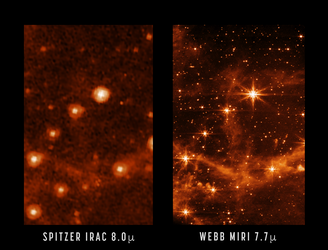

Webb takes its first exoplanet image
For the first time, astronomers have used the NASA/ESA/CSA James Webb Space Telescope to take a direct image of an exoplanet. The exoplanet is a gas giant, meaning it has no rocky surface and could not be habitable. The image, as seen through four different light filters, shows how Webb’s powerful infrared gaze can easily capture worlds beyond our Solar System, pointing the way to future observations that will reveal more information than ever before about exoplanets.
The exoplanet in Webb’s image, called HIP 65426 b, is about six to eight times the mass of Jupiter. It is young as planets go – about 15 to 20 million years old, compared to our 4.5-billion-year-old Earth.
Astronomers discovered the planet in 2017 using the SPHERE instrument on the European Southern Observatory’s Very Large Telescope in Chile and took images of it using short infrared wavelengths of light. The Webb image, taken in mid-infrared light, reveals new details that ground-based telescopes would not be able to detect because of the intrinsic infrared glow of Earth’s atmosphere.
Researchers have been analysing the data from these observations and are preparing a paper they will submit to journals for peer review. But Webb's first capture of an exoplanet already hints at future possibilities for studying distant worlds.
Since HIP 65426 b is about 100 times farther from its host star than Earth is from the Sun, it is sufficiently distant from the star that Webb can easily separate the planet from the star in the image.
Webb’s Near-Infrared Camera (NIRCam) and Mid-Infrared Instrument (MIRI) are both equipped with coronagraphs, which are sets of tiny masks that block out starlight, enabling Webb to take direct images of certain exoplanets like this one.
Taking direct images of exoplanets is challenging because stars are so much brighter than planets. The HIP 65426 b planet is more than 10 000 times fainter than its host star in the near-infrared, and a few thousand times fainter in the mid-infrared. While this is not the first direct image of an exoplanet taken from space – the NASA/ESA Hubble Space Telescope has captured direct exoplanet images previously – HIP 65426 b points the way forward for Webb’s exoplanet exploration.
In each filter image, the planet appears as a slightly differently shaped blob of light. That is because of the particulars of Webb’s optical system and how it translates light through the different optics. Purple shows the NIRCam instrument’s view at 3.00 micrometres, blue shows the NIRCam instrument’s view at 4.44 micrometres, yellow shows the MIRI instrument’s view at 11.4 micrometres, and red shows the MIRI instrument’s view at 15.5 micrometres. These images look different because of the ways that the different Webb instruments capture light. The small white star in each image marks the location of the host star HIP 65426, which has been subtracted using the coronagraphs and image processing. The bar shapes in the NIRCam images are artifacts of the telescope’s optics, not objects in the scene.
These observations were lead with a large international collaboration by Sasha Hinkley, associate professor of physics and astronomy at the University of Exeter in the United Kingdom.
Notes:
NIRSpec was built for ESA by a consortium of European companies led by Airbus Defence and Space (ADS) with NASA’s Goddard Space Flight Centre providing its detector and micro-shutter subsystems. ESA also provided 50% of MIRI, which was designed and built by a consortium of nationally funded European Institutes (The MIRI European Consortium) in partnership with JPL and the University of Arizona.
This image highlights Webb’s science in progress, which has not yet been through the peer-review process.





